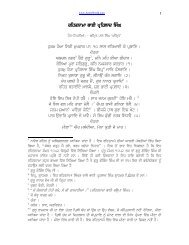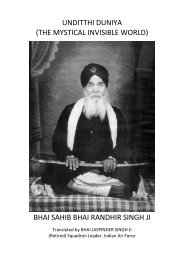Guru Gobind Singh's Death at Nanded Examination of - Vidhia.com
Guru Gobind Singh's Death at Nanded Examination of - Vidhia.com
Guru Gobind Singh's Death at Nanded Examination of - Vidhia.com
Create successful ePaper yourself
Turn your PDF publications into a flip-book with our unique Google optimized e-Paper software.
40 AN EXAMINATION OF SUCCESSION THEORIES<br />
mdkhi, as he himself puts it—were not wholly acceptable to<br />
objective students and scholars <strong>of</strong> history. He, therefore,<br />
readily revised his Panth Prakash and issued a new edition <strong>of</strong><br />
it, leaving out fanciful myths and accretions.<br />
The l<strong>at</strong>est manuscript <strong>of</strong> the Panth Prakash prepared by<br />
Giani Gian'Singh towards the end <strong>of</strong> his life for public<strong>at</strong>ion<br />
by Hafiz Qutb-ud-Din <strong>of</strong> Lahore is also free from the above<br />
legends (pp. 105 a-b, No. 59-73).<br />
In addition to the several editions <strong>of</strong> the Giani's Panth<br />
Prakash, we have a number <strong>of</strong> editions <strong>of</strong> his Tawarikh <strong>Guru</strong><br />
Khalsa, first published <strong>at</strong> Sialkot in 1891 A.D. Therein also<br />
we find no mention <strong>of</strong> the legends referred to above, while<br />
there is a clear mention <strong>of</strong> <strong>Guru</strong> <strong>Gobind</strong> Singh having formally<br />
installed the <strong>Guru</strong> Granth Sahib as <strong>Guru</strong> after him. [Vide<br />
part I, p. 356.]<br />
As we have seen above, all the contemporary records and<br />
early accounts written by the Sikhs up to the end <strong>of</strong> the<br />
nineteenth century refer to the de<strong>at</strong>h <strong>of</strong> <strong>Guru</strong> <strong>Gobind</strong> Singh<br />
and crem<strong>at</strong>ion <strong>of</strong> his body <strong>at</strong> <strong>Nanded</strong> on K<strong>at</strong>ik Sudi 5, 1765,<br />
Bikrami as indisputable historical facts. There is only the<br />
difference <strong>of</strong> style <strong>of</strong> language used by different writers. While<br />
the objective historians and the writers <strong>of</strong> <strong>of</strong>ficial memoirs<br />
and Akhbars use a straightforward and businesslike language,<br />
the poetic hagiographers indulge in figur<strong>at</strong>ive phraseology.<br />
As the words like mirtu and maut (de<strong>at</strong>h) are considered<br />
to be blunt when used for saints and sages, the Sikh writers have<br />
used refined and polished words and phrases like pralok gamne,<br />
Dev-lok padhare, jotijot samane, alop bhae (went to the other<br />
world, went to the land <strong>of</strong> gods, light blended with the Light,<br />
disappeared to heaven), etc., etc. Even in ordinary language<br />
the words swarg vds hud (has gone to heaven) are used for mar<br />
gaya (has died). This is not peculiar to Panjabi and Urdu,<br />
but to all oriental languages. In Persian and Urdu also, words<br />
like intiqdl (transfer, migr<strong>at</strong>ion), rehl<strong>at</strong> (march, departure),<br />
maraham<strong>at</strong> (God's mercy), etc., are used for de<strong>at</strong>h, and<br />
marhum, an jahani, bihishti (taken in God's mercy, otherwordly,<br />
<strong>of</strong> heavenly) are used for the deceased. As such, the<br />
GURU GOBIND SINGH'S DEATH AT NANDED<br />
words used by Sikh poets and hagiographers in the Gur-bilds<br />
the Suraj Parkdsh, the Panth Parkdsh, etc., have no other<br />
meaning except referring to the n<strong>at</strong>ural de<strong>at</strong>h <strong>of</strong> the <strong>Guru</strong>.<br />
As to the stories <strong>of</strong> the <strong>Guru</strong> having been seen, after his de<strong>at</strong>h<br />
and crem<strong>at</strong>ion, by a wood-cutter or an Udasi sddhu or <strong>of</strong> his<br />
mysterious visits to the fort <strong>of</strong> S<strong>at</strong>ara and other places, they<br />
are nothing more than unhistorical baseless legends cre<strong>at</strong>ed<br />
out <strong>of</strong> the fertile imagin<strong>at</strong>ion <strong>of</strong> poets, who have borrowed<br />
their ideas from ancient Hindu mythology, Christan and<br />
Muslim hagiographs and from earlier Sikh Janam-sakhis.<br />
They are things unreal, untruthful and unhistorical on the<br />
very face <strong>of</strong> them and deserve to be ignored.<br />
The disappearance <strong>of</strong> the <strong>Guru</strong>'s kumait or bay horse<br />
from his stable <strong>at</strong> the time <strong>of</strong> the <strong>Guru</strong>'s crem<strong>at</strong>ion also seems<br />
to be a part <strong>of</strong> the legend. But even if it were a fact, it lends<br />
no support to the bodily disappearance <strong>of</strong> the <strong>Guru</strong> from the<br />
burning pyre or from the crem<strong>at</strong>ion enclosure.<br />
7. HISTORICAL EVIDENCE ON THE GURU'S LAST DAYS<br />
AND DEATH<br />
Having referred to <strong>of</strong>ficial records, contemporary works<br />
and hagiological liter<strong>at</strong>ure, we now <strong>com</strong>e to historical works<br />
<strong>of</strong> the eighteenth and nineteenth centuries based on the<br />
inform<strong>at</strong>ion available to, or collected by, pr<strong>of</strong>essional historians.<br />
They are either in Persian or in English. The works written<br />
by Indian scholars, both Hindu and Muslim, are in Persian<br />
while those <strong>of</strong> the Europeans are in English. As almost all the<br />
Indian writers belonged to the Panjab or its neighbourhood,<br />
they had either lived amongst the Sikhs as neighbours or<br />
had close associ<strong>at</strong>ions with them in day-to-day life. As such,<br />
most <strong>of</strong> them had firsthand knowledge <strong>of</strong> the prevalent beliefs,<br />
practices and ceremonies <strong>of</strong> the Sikhs and could, therefore,<br />
speak with a certain amount <strong>of</strong> authority. Some <strong>of</strong> them might<br />
have differed with the Sikhs in m<strong>at</strong>ters theological or might<br />
as well have had political prejudices against them, but about<br />
the broad facts <strong>of</strong> their history there could be no misgivings.<br />
Moreover, as writers, they are expected to be impartial and<br />
objective. And to be as near truth as possible, they must have<br />
41





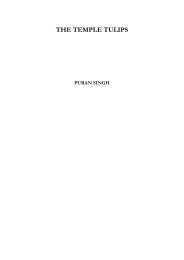
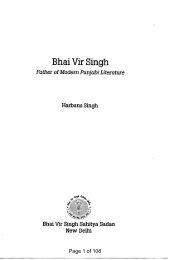

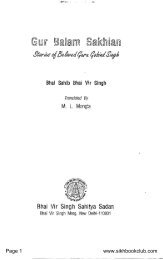
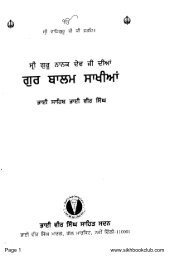
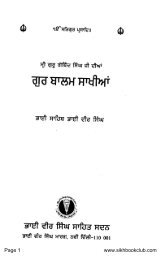
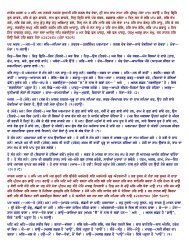
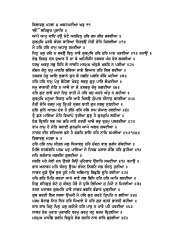

![cOpeI ] hmrI kro hwQ dY r~Cw ] pUrn hoie ic~q kI ie ... - Vidhia.com](https://img.yumpu.com/12240258/1/190x245/copei-hmri-kro-hwq-dy-rcw-purn-hoie-icq-ki-ie-vidhiacom.jpg?quality=85)
